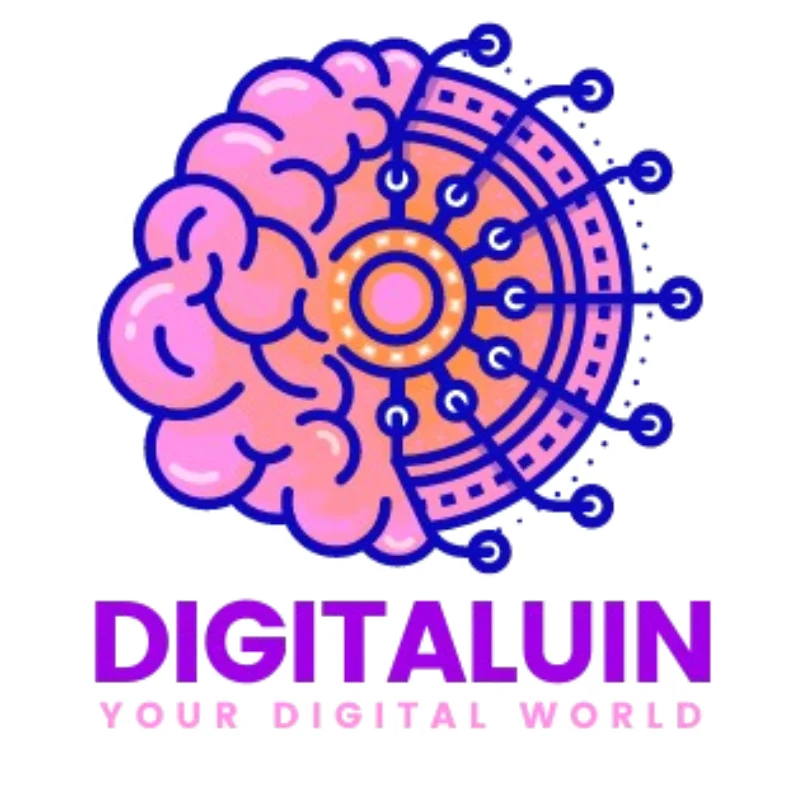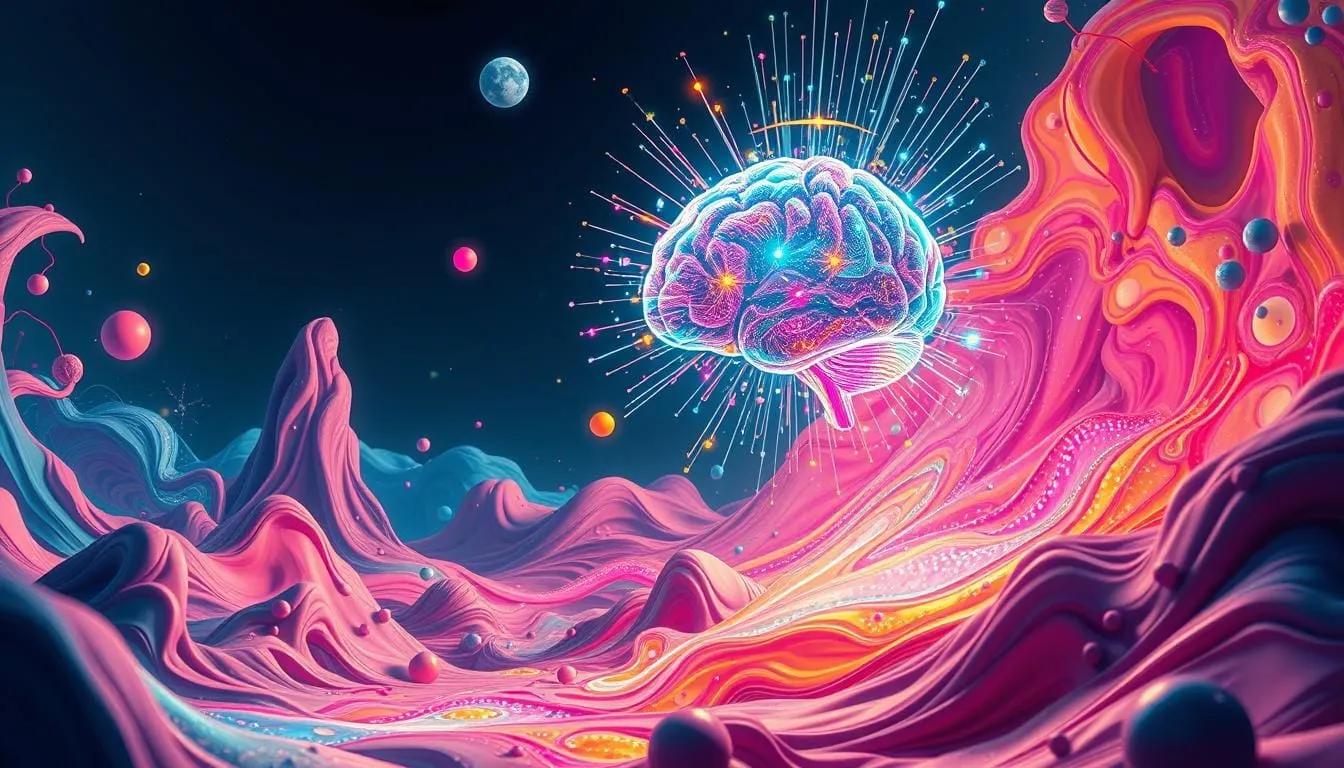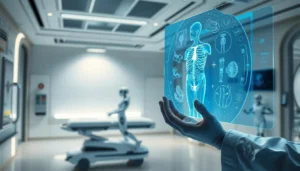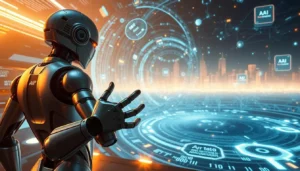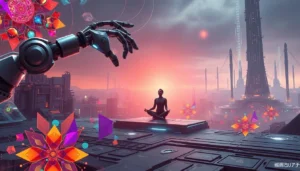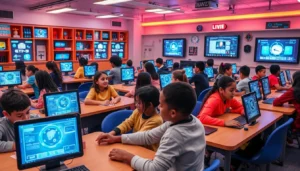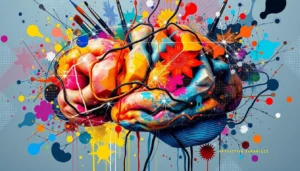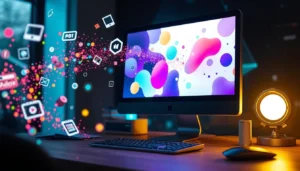AI and Creativity: Can Machines Be Truly Creative?
Artists, innovators, and the public wonder if machines can be creative. With ChatGPT reaching 100 million users, the mix of AI and creativity is a hot topic. It’s a debate that’s growing fast.
AI has made art, music, and stories that challenge our old ideas of creativity. It’s making us rethink what it means to be creative. From AI songs to AI stories, these systems are pushing our limits.
We’re going to look at how AI and creativity are changing together. We’ll talk about important moments, current trends, and the big question: Can machines really be creative? Let’s dive into the world where AI meets the arts and see if machines can truly create.
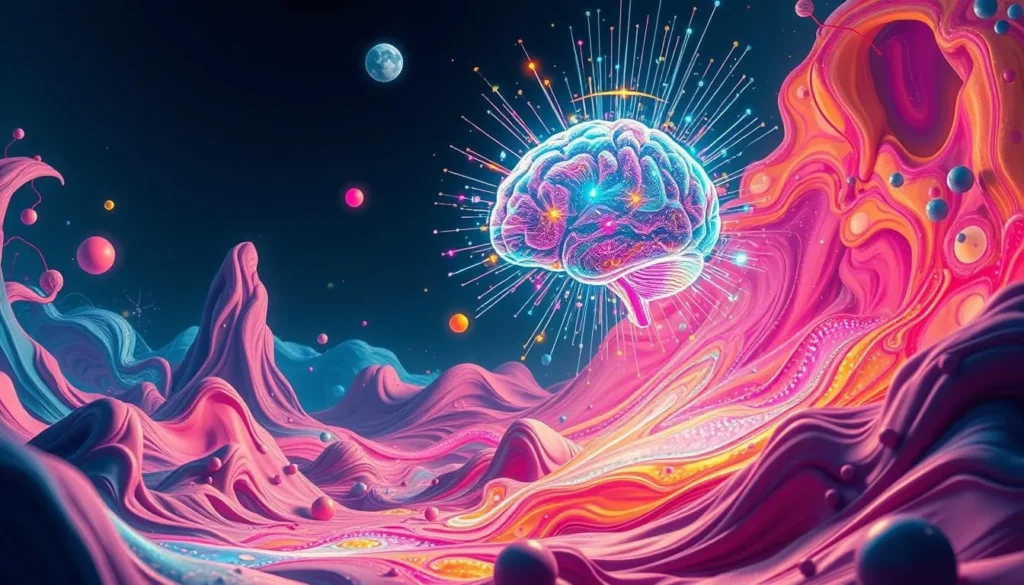
Table of Contents
Understanding Creativity in Humans
Creativity is at the heart of human ingenuity. It’s a complex process that involves coming up with new and useful ideas. These ideas often challenge the usual ways of thinking.This ability to think differently is linked to our emotions, life experiences, and how we understand the world.
Definition of Creativity
Creativity means making new combinations of existing ideas. It’s what makes us different from machines. It requires emotional depth and understanding that machines can’t match.
The Role of Emotion in Creativity
Emotions are key in creativity. Human creativity comes from our personal stories, cultural views, and emotional smarts. This gives our work a real and deep feel that AI can’t match.
The spark of inspiration in humans is hard for machines to grasp. Machines rely on data and algorithms, not the same as human intuition.
Different Types of Human Creativity
- Artistic Expression: Turning emotions, experiences, and ideas into art.
- Problem-Solving: Finding new ways to solve challenges.
- Innovative Thinking: Coming up with new ideas and solutions.
While AI can generate lots of ideas, it can’t match human emotional creativity. The difference between human and machine creativity is getting smaller. It’s important to value what makes human creativity special.
The Evolution of Artificial Intelligence
Artificial intelligence (AI) has grown from simple algorithms to advanced systems today. The field has seen big leaps forward, thanks to machine learning and deep learning. These advancements have made AI much more capable.
Brief History of AI
The story of AI starts in the 1950s, when experts began working on smart machines. Since then, AI has grown, moving from simple rules to complex, self-learning systems. These systems are now at the heart of many modern AI applications.
Key Milestones in AI Development
- The 1980s saw the creation of neural networks, which let AI systems learn and adapt like humans.
- In the 1990s, machine learning algorithms emerged, enabling AI to analyze big data and make decisions.
- The 2000s brought deep learning, which greatly improved AI’s ability to understand and create human-like content.
Current Trends in AI Research
Now, AI research aims to make machines better at understanding and creating human-like content. This includes natural language, computer vision, and creative tasks. AI history, machine learning advancements, and deep learning are key areas of focus. They help push AI’s limits.
As AI keeps evolving, the mix of human and machine creativity will stay interesting. People are exploring both the good and bad sides of AI’s creative abilities.
Types of AI and Their Capabilities
Artificial Intelligence (AI) comes in many forms, from narrow AI for specific tasks to general AI that tries to think like humans. Machine learning and deep learning form the foundation of artificial intelligence. These methods help AI get better with experience and data.
Narrow AI vs. General AI
Narrow AI, or weak AI, is great at one thing, like playing chess or diagnosing diseases. It’s very good at what it does but can’t think like humans. General AI, or strong AI, aims to be as smart as us. It wants to solve many problems, not just one.
Machine Learning and Deep Learning
Machine learning and deep learning are key to AI today. Machine learning lets AI learn from data and make predictions. Deep learning uses brain-like networks to handle complex data, like images and text.
Generative Adversarial Networks (GANs)
Generative Adversarial Networks (GANs) are a big step forward in AI’s creativity. They use two networks to create new, realistic content, like images and music. This lets AI do more than just recognize patterns; it can create new things.
| Characteristic | Narrow AI | General AI |
|---|---|---|
| Task Scope | Specialized for a specific task or domain | Capable of performing a wide range of tasks |
| Flexibility | Limited to the task it was designed for | Adaptable to new, unfamiliar tasks |
| Learning Ability | Learns within the confines of its domain | Capable of open-ended learning and understanding |
| Reasoning | Operates based on pre-programmed rules and algorithms | Exhibits human-like reasoning and problem-solving |
| Consciousness | Lacks self-awareness and subjective experience | Potentially possesses self-awareness and conscious experience |
The difference between narrow and general AI is still being studied. Narrow AI has already helped in many areas, but general AI is still a dream. If achieved, it could change how we use technology and solve problems.
Case Studies of AI in Creative Fields
AI has made a big impact on creative industries. It has created art that sold at major auctions and music that sounds like famous artists. AI’s abilities in creativity are amazing. Let’s explore examples that showcase the broad scope of AI’s creative potential.
AI in Visual Arts
AI has shown it can make art that people love and buy. For example, a painting made by AI was sold at Christie’s for $432,500 in 2018. This event highlighted AI’s ability to produce art that is both captivating and intellectually stimulating.
AI in Music Composition
AI has also changed music. OpenAI’s MuseNet can make music in many styles, from classical to rock. It processes vast datasets to craft innovative melodies and harmonies. This could change how we make music, mixing AI’s precision with the feeling of human music.
AI in Writing and Literature
AI has revolutionized writing, with models like GPT-3 generating text that feels authentically human. It can write stories, poems, and even novels. While AI writing isn’t as deep as human writing yet, it’s getting better. AI can help writers with ideas, writing, and editing, making creativity easier.
These examples show AI can expand creativity in many areas. The debate on AI creativity is ongoing, but it’s clear AI is changing how we create. It opens new ways for humans and machines to work together.
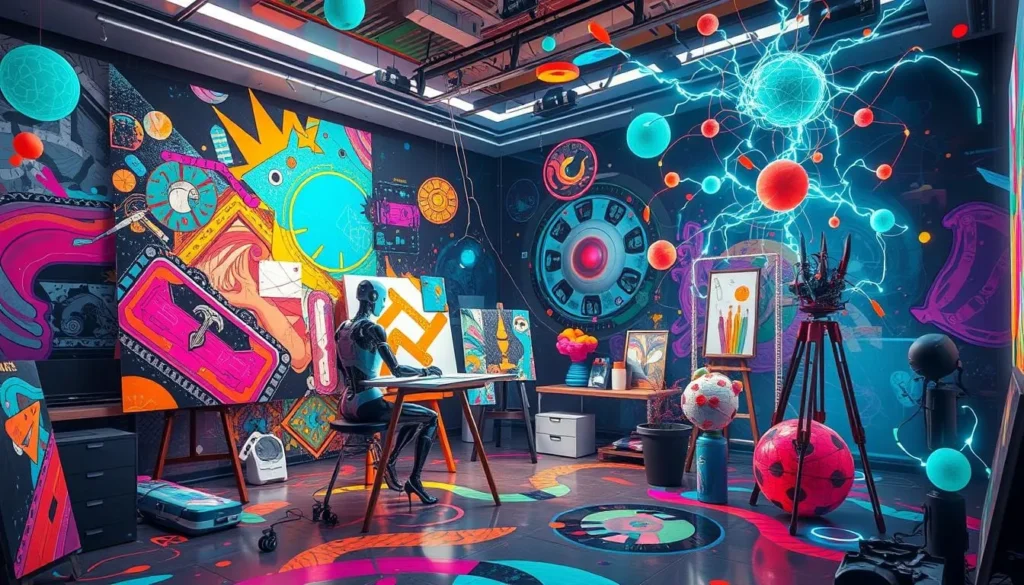
The Mechanics of AI Creativity
AI creativity is a fascinating field that explores how machines create. It uses algorithms to find inspiration in vast amounts of data. It also uses randomness to come up with new ideas.
Deep learning and neural networks are key in AI’s creative process. These tools help machines find patterns and mix things up in new ways. This makes their content seem original and fresh.
Randomness, added through methods like GANs, boosts AI’s creativity. It lets AI systems think outside the box. This leads to new artistic expressions and solutions.
The way AI creates is a big step forward in AI research. As AI gets better, it opens up new possibilities for humans and machines to work together. This technology has the power to redefine art, music, and literature on a large scale.
“Intelligence often describes the abilities humans retain until machines successfully replicate them.” – Tesler’s Theorem
The story of AI creativity is exciting. It blends algorithms, datasets, and randomness to produce extraordinary results. As we delve deeper into AI, we uncover its potential to redefine creativity.
| Metric | Description | Significance |
|---|---|---|
| Fluency | The ability to generate a large number of ideas or solutions. | Indicates the breadth and depth of an AI system’s creative potential. |
| Flexibility | The ability to shift between different categories or types of ideas. | Reflects the adaptability and versatility of an AI’s creative process. |
| Originality | The uniqueness and novelty of the ideas or solutions generated. | Showcases the AI system’s capability to produce genuinely innovative content. |
| Elaboration | The level of detail and complexity in the ideas or solutions generated. | Demonstrates the AI’s ability to develop and refine its creative outputs. |
Limitations of AI Creativity
AI has made big strides in creativity, but it still has big limits. It can’t feel emotions deeply or really understand the context of what it creates. This means AI art or writing often misses the emotional depth that humans take for granted.
AI also relies too much on what it’s already learned. It mostly recombines old ideas instead of coming up with new ones. This can lead to old biases and a lack of fresh ideas, making AI’s creativity limited.
Ethical Considerations in AI Creativity
There are also big ethical questions with AI creativity. Who owns the work made by AI? How do we deal with copyright and the jobs of human creators? These are big issues that need careful thought.
To make the most of AI in creative fields, we need to understand its limits and think about ethics. By knowing what AI can and can’t do, we can work together with it. This way, we can make the creative process better and open up new ways to innovate.
“AI generates outputs by analyzing patterns in its training data, demonstrating its strength in reassembling existing ideas rather than inventing entirely new ones.”– Julie from AI Fire
| Limitation | Explanation |
|---|---|
| Lack of Emotional Depth | AI-generated content often lacks the nuanced emotional resonance found in human creations, failing to capture the complexities of the human experience. |
| Dependency on Existing Data | AI’s creative output is heavily influenced by the data it is trained on, leading to the perpetuation of biases and a lack of true originality. |
| Ethical Considerations | Issues of authorship, copyright, and the potential displacement of human creators pose significant challenges to the widespread adoption of AI in creative fields. |
The Debate: Can Machines Be Truly Creative?
The debate on whether machines can be truly creative is complex. As artificial intelligence (AI) gets better, people wonder if machines can be as creative as humans. This question is a big topic among experts.
Perspectives from Experts
Some say AI can be creative by making new combinations and ideas. For example, studies show that large language models (LLMs) help people come up with more creative ideas. People scored 10% higher in creativity tasks with LLMs than with search engines.
An AI chatbot like ChatGPT can also be creative. It even scores high in tasks that need a human touch, like making sentimental items useful again.
Arguments for and Against AI Creativity
But others think true creativity needs consciousness and feelings, which AI doesn’t have. IBM’s Jacob Murel says AI can make creativity better but can’t replace humans. AI’s creations are limited to the data it has been trained on.
Associate Professor Sabrina Habib also has concerns. She thinks AI tools like ChatGPT can help but might also make ideas too similar. This reliance on pre-existing data could result in a lack of originality and ethical depth.
The Future of Creative Collaboration
The future of creativity might be about working together with machines. AI can help spark new ideas and make product development faster. This lets teams quickly try out many ideas and then focus on the best ones.
But, human creativity is still seen as the best. Machines act as tools that assist and enhance the creative process. As AI keeps getting better, the debate on machine creativity will keep going. The idea of working together with AI in creativity will also grow.
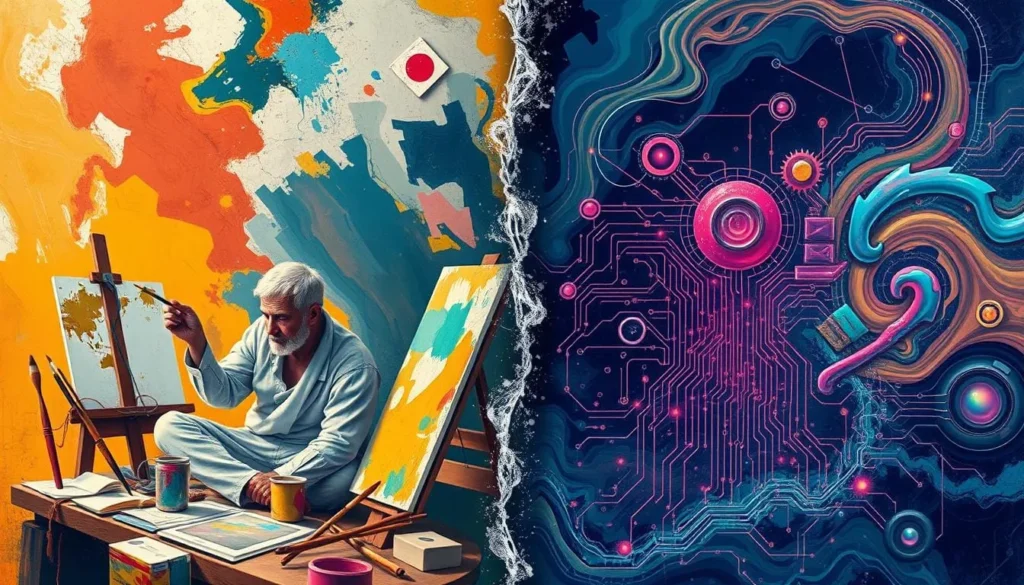
Human-AI Collaboration in Creativity
The emergence of human-AI collaboration is reshaping the way we create. AI tools help by automating tasks and offering insights. Together, humans and AI can explore new creative areas.
Enhanced Creativity Through AI Tools
AI tools are key in creative work, freeing us from mundane tasks. They help with everything from designing graphics to writing stories. This lets humans concentrate on the creative ideas, while AI handles the details.
Examples of Successful Collaborations
- In graphic design, AI helps create unique styles and colors, expanding creative options.
- AI music tools compose melodies, which humans then refine into complete songs.
- AI writing tools analyze and suggest ideas, aiding authors in their work.
The Role of Human Input
AI is creative, but human touch is still crucial. Humans add emotion and understanding that AI can’t match. This collaboration ensures the final product is meaningful and reflects the creator’s vision.
“The synergy between human ingenuity and AI-powered innovation unlocks endless possibilities for creative industries.”
As AI becomes more integrated in creative work, the future looks bright. By combining AI-assisted creativity, creative collaboration, and human-AI synergy, we can explore new artistic territories.
The Impact of AI on Creative Industries
Artificial intelligence (AI) is changing the creative industries a lot. It’s making new job roles and changing what skills are needed. The future of creative work will mix human creativity with AI help.
Changes in Job Roles
AI is taking over simple tasks in creative fields like graphic design and music. This might make some jobs disappear. But, it also opens up new chances for those who know how to use AI well.
Now, jobs focus more on thinking strategically, understanding emotions, and working with AI. This is a big shift.
Challenges and Opportunities
- AI tools like logo design platforms and writing assistants are making things easier and more accessible for new creatives.
- Applications like DeepArt and DALL-E are revolutionizing the visual arts landscape. They let artists make amazing images with algorithms, opening up new ways to express.
- Platforms such as Endel leverage AI to craft personalized audio experiences. This meets the growing need for unique creative experiences.
Future Predictions for Creative Work
The future of creative work will focus on personalized and data-driven outputs. AI will keep getting better, helping creatives make more tailored work. They’ll need to learn to work with AI, focusing on making smart decisions, understanding emotions, and using AI to improve their work.
| Timeframe | AI Developments in Creative Industries |
|---|---|
| 1960s | Algorithmic art emerged with pioneers like Harold Cohen and his program, AARON. |
| 1970s-1980s | Significant advancements in computer graphics and procedural generation occurred. |
| 1990s | AI started entering music and literature with programs like EMI and RACTER. |
| 2000s | Advancements in machine learning, neural networks, and the introduction of GANs took place. |
| 2010s | AI tools like DeepArt, Jukedeck, and Grammarly started developing as creative collaborators. |
| 2020s and beyond | The focus is on hyper-realistic art and animation, personalized creative experiences, and ethical AI. |
AI’s impact on creative industries is clear. The future lies in striking a balance between human originality and AI’s capabilities. As AI grows, creatives must update their skills to succeed. They need to embrace AI’s benefits while facing its challenges.
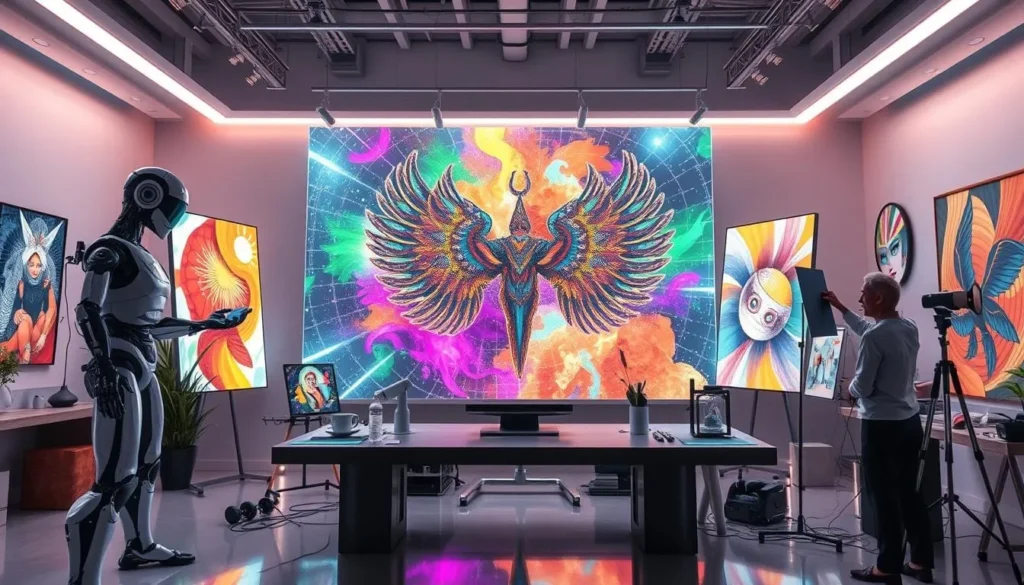
Public Perception of AI Creativity
Opinions differ widely on AI’s role in creative domains. Some see AI-generated art and content as exciting, while others doubt its value. Misunderstandings about AI’s abilities are common, leading to both overestimation and underestimation.
Attitudes Toward AI in the Arts
Advanced AI tools like DALL-E 2, ChatGPT, and Runway have sparked debate. Some love the new visuals and ideas AI brings. Others think AI art lacks the emotional depth of human art.
Misconceptions About AI Creatives
Many think AI can replace human artists, while others doubt its abilities. While AI enhances human creativity, it cannot replace it entirely. Human touch and intuition are still needed in art.
The Need for AI Literacy
There’s a growing need for AI literacy in creative industries. Understanding AI’s strengths and weaknesses helps judge AI content’s value. This knowledge ensures AI is used responsibly in art.
“AI has expanded my creative horizons, serving as a tool to enhance my abilities rather than replace them.”
As AI grows, it’s important to keep a balanced view. AI perception, AI in arts, and AI education are key to the future of creativity. These tools enable collaboration between humans and machines, pushing the boundaries of artistic exploration.
Conclusion: The Future of Creativity
The future of creativity will likely see humans and AI working together. AI is already showing great creativity, but humans bring a special touch. This touch includes deep emotions and understanding of context. AI should be regarded as an aid to human creativity, not a substitute for it.
AI is changing how we create, opening up new ways to express ourselves. Digital art made with AI, like NFTs, is becoming more popular. Some pieces even sell for over $200,000. Also, 72% of creatives think AI will make more and varied content possible.
Working together, humans and AI can create something truly new. A 2023 Adobe survey found 75% of creatives think AI will change their work in five years. Already, 39% use AI in their work. This mix of human and machine creativity could lead to amazing new ideas and possibilities.
